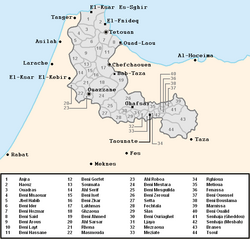جبالة | |
|---|---|
 Map of territories inhabited by Jebala in Northern Morocco | |
| Total population | |
| 1,284,000[citation needed] | |
| Regions with significant populations | |
| Northern Morocco, mostly concentrated in north-west Morocco and Rif | |
| Languages | |
| Jebli Arabic | |
| Religion | |
| Sunni Islam |
The Jebala (Arabic: جبالة, romanized: Jbāla) are a tribal confederation inhabiting an area in northwest Morocco from the town of Ketema to the west. The Jbala region thus occupies the western part of the Rif mountains. The Jbala has a population of 1,284,000[citation needed] and is divided into over 40 tribes,[1] today known as "rural communes" (جماعات قروية), and adjacent to them are a small group of nine tribes called the Ghmara (غمارة), who inhabit the territory between the line of mountain peaks to the north of Chefchaouen and the Mediterranean Sea. In addition to tribal heterogeneity, this region is also geographically diverse. High mountains are interspersed with hills and flatlands, and local inhabitants settle in both the high mountains and valleys. In addition to the rainy climate, which influences the way the inhabitants build their houses as well as their special agricultural practices,[2] there are also numerous cultural characteristics that contribute to an emphasised sense of identity[3] and make the Jbala people clearly distinguishable from their neighbours from the eastern part of the Rif Mountains (Riafa or Rwafa) where the climate is more arid, and from the former shepherds from the Atlantic coast (‘Arab). There are only a few cities in the country of the Jbala, and its population remains mostly rural. During the Middle Ages, chroniclers and historians knew the Jbala under their original name, Ghomara.[4][5]
- ^ Hart, D. M. (1999), « Luchas hereditarias rifeñas o vendettas rifeñas y segmentación o anti-segmentación ? Datos adicionales sobre los Ait Uriagel y contestación parcial a Henry Munson », Hart y Rachid Raha (dir.), La sociedad bereber del Rif marroquí. Sobre la teoría de la segmentaridad en el Magreb, Grenade, Universidad de Granada, Diputación Provincial de Granada, Série Historia y Antropología del Magreb contemporáneo.
- ^ Ater M. et al. (2018), « Agrosystèmes traditionnels et savoirs agronomiques des paysans du pays Jbala (Rif occidental) », Les Jbala. Peuplement, langue et ruralité, Actes des rencontres de Chefchaouen, Taounate et Larache, 2011, 2012, 2014, coordination M. Mezzine, J. Vignet-Zunz, F. Brigui, soutien de l’Ass. Targa-AIDE, Rabat. Also see: Hmimsa Y. et al., (2012), “Vernacular taxonomy, classification and varietal diversity of fig (Ficuscarica L.) among Jbala cultivators in Northern Morocco”, Human Ecology. DOI:10.1007/s10745-012-9471-x.
- ^ Vignet-Zunz, J. (2014), Les Jbala du Rif. Des lettrés en montagne, Casablanca: Éditions la Croisée des Chemins.: 23-40.
- ^ Mezzine M. (2018), « Le peuplement du Maroc au-delà des cartes : le cas des populations du pays Jbala/Ghmara », Les Jbala. Peuplement, langue et ruralité, Actes des rencontres de Chefchaouen, Taounate et Larache, 2011, 2012, 2014, coordination M. Mezzine, J. Vignet-Zunz, F. Brigui, soutien de l’Ass. Targa-AIDE, Rabat.
- ^ Martinez Enamorado V. (2018), « Les significations historiques du vocable « Rif » », Les Jbala. Peuplement, langue et ruralité, Actes des rencontres de Chefchaouen, Taounate et Larache, 2011, 2012, 2014, coordination M. Mezzine, J. Vignet-Zunz, F. Brigui, soutien de l’Ass. Targa-AIDE, Rabat.